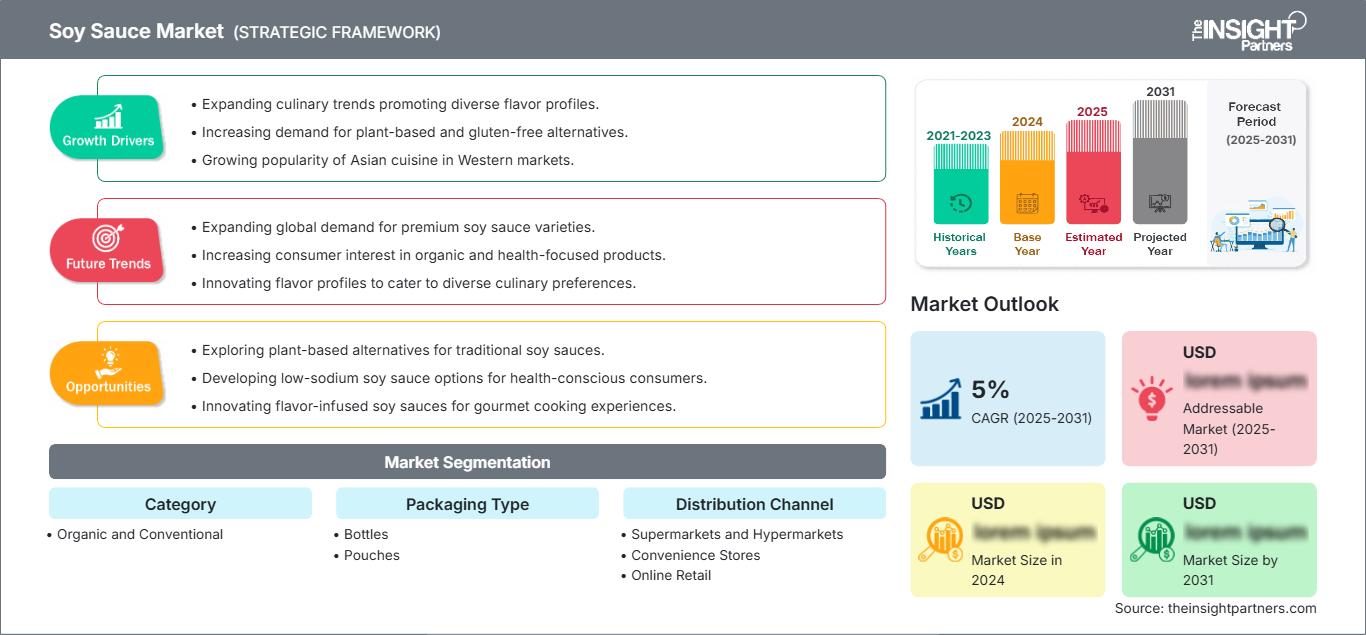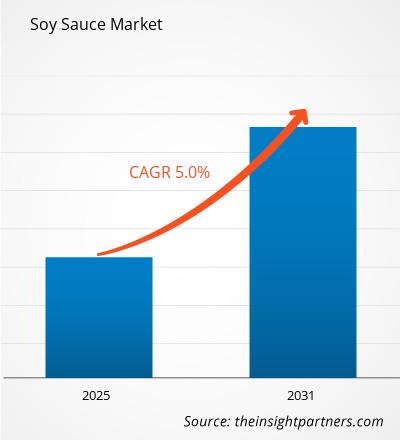Si prevede che il mercato della salsa di soia registrerà un CAGR del 5% tra il 2023 e il 2031. La crescente propensione per l'acquisto online di generi alimentari, inclusa la salsa di soia, rimarrà probabilmente un trend chiave del mercato.
Analisi di mercato della salsa di soia:
- La salsa di soia è un condimento fermentato popolare, comunemente utilizzato nella cucina asiatica. È prodotta con semi di soia, grano, acqua e sale. La salsa di soia ha un colore marrone scuro e un sapore umami e saporito. È un ottimo accompagnamento che esalta e conferisce complessità a zuppe, stufati e piatti bolliti.
- Alcuni dei fattori chiave che guidano la crescita del mercato della salsa di soia includono la crescente domanda di un'alimentazione sana da parte delle masse, la crescente popolarità delle diete a base vegetale tra i consumatori attenti alla salute e vegani e il crescente numero di ristoranti asiatici in tutto il mondo. Ancora più importante, il mercato è trainato anche da un aumento della domanda di salsa di soia da parte di produttori e importatori di alimenti come ingrediente utilizzato per esaltare il sapore e il sapore dei piatti preparati da loro e dai ristoratori.
Panoramica del mercato della salsa di soia
- L'Asia-Pacifico ha rappresentato la maggior parte della quota di mercato della salsa di soia. Paesi come Cina e Giappone sono tra i maggiori produttori e consumatori di salsa di soia nella regione. L'adozione è stata in gran parte trainata anche dall'enorme popolazione di paesi come Cina, Giappone e Corea del Sud e dalla crescente popolarità di salse etniche e speciali.
- La domanda di salsa di soia è destinata ad aumentare a causa della crescente consapevolezza della salute e della crescente propensione verso diete a base vegetale, della crescente popolarità della cucina asiatica in tutto il mondo e dell'utilizzo della salsa di soia come esaltatore di sapore da parte di produttori e ristoranti di alimenti.
Personalizza questo rapporto in base alle tue esigenze
Potrai personalizzare gratuitamente qualsiasi rapporto, comprese parti di questo rapporto, o analisi a livello di paese, pacchetto dati Excel, oltre a usufruire di grandi offerte e sconti per start-up e università
Mercato della salsa di soia: Approfondimenti strategici

- Ottieni le principali tendenze chiave del mercato di questo rapporto.Questo campione GRATUITO includerà l'analisi dei dati, che vanno dalle tendenze di mercato alle stime e alle previsioni.
Driver e opportunità di mercato della salsa di soia: crescente interesse dei consumatori per la cucina cinese e giapponese
Potrai personalizzare gratuitamente qualsiasi rapporto, comprese parti di questo rapporto, o analisi a livello di paese, pacchetto dati Excel, oltre a usufruire di grandi offerte e sconti per start-up e università
Mercato della salsa di soia: Approfondimenti strategici

- Ottieni le principali tendenze chiave del mercato di questo rapporto.Questo campione GRATUITO includerà l'analisi dei dati, che vanno dalle tendenze di mercato alle stime e alle previsioni.
- Un numero crescente di consumatori che esplorano cucine diverse e palati avventurosi hanno stuzzicato le papille gustative, spingendole a guardare oltre l'Europa alla ricerca di autentici sapori asiatici, e un condimento che si è dimostrato popolare e semplice da usare è la salsa di soia. Pilastro della cucina asiatica da secoli, la salsa di soia svolge un ruolo cruciale in molte famiglie. Può conferire immediatamente un sapore umami a piatti sia caldi che freddi ed è diventata un elemento essenziale nelle cucine di tutto il mondo.
- Il suo patrimonio culturale e la gustosa combinazione di cibi fanno sì che i buongustai desiderino piatti cinesi e giapponesi, come i delicati involtini di sushi o i saporiti piatti saltati in padella del Sichuan. Tutto ciò ha dato impulso al mercato della salsa di soia in tutto il mondo.
Opportunità di sviluppo della salsa di soia a basso contenuto di sodio
- La domanda di salsa di soia a basso contenuto di sodio è in aumento a causa della preoccupazione globale per l'assunzione di sodio per la salute umana. Secondo l'Organizzazione Mondiale della Sanità (OMS), oltre il 70% della popolazione mondiale ha un elevato apporto di sodio, che è collegato a un elevato rischio di ipertensione e malattie cardiache. Pertanto, i consumatori sono spinti a cercare salsa di soia a basso o ridotto contenuto di sodio per tenere sotto controllo l'assunzione giornaliera di sodio e allo stesso tempo aggiungere il sapore saporito della salsa di soia ai propri pasti.
- I produttori stanno lanciando nuovi prodotti con diverse affermazioni sulla salute per attrarre un gran numero di consumatori. La salsa di soia a basso contenuto di sodio, la salsa di soia senza glutine, la salsa di soia biologica e non OGM e la salsa di soia aromatizzata stanno diventando sempre più comuni e offrono maggiori opportunità di crescita del mercato.
Segmentazione del mercato della salsa di soia
L'ambito del mercato globale della salsa di soia è stato segmentato in base al tipo di imballaggio, alla categoria e al canale di distribuzione.
- In base al tipo di imballaggio, il mercato della salsa di soia è suddiviso in bottiglie, bustine e altri.
- In base alla categoria, il mercato è suddiviso in biologico e convenzionale.
- In base al canale di distribuzione, il mercato è segmentato in supermercati e ipermercati, minimarket, vendita al dettaglio online e altri.
Analisi della quota di mercato della salsa di soia per area geografica
- Il rapporto sul mercato della salsa di soia comprende un'analisi dettagliata di cinque principali regioni geografiche, che include le dimensioni attuali e storiche del mercato e le previsioni per il periodo 2021-2031, coprendo il Nord America, Europa, Asia-Pacifico (APAC), Medio Oriente e Africa (MEA) e America Meridionale e Centrale.
- Ogni regione è ulteriormente suddivisa in paesi di riferimento. Questo rapporto fornisce analisi e previsioni per oltre 18 paesi, analizzando le dinamiche del mercato della salsa di soia, come fattori trainanti, tendenze e opportunità che influenzano i mercati a livello regionale.
- Inoltre, il rapporto include l'analisi delle cinque forze di Porter, che prevede lo studio dei principali fattori che influenzano il mercato della salsa di soia in queste regioni.
Mercato della salsa di soia
Le tendenze regionali e i fattori che influenzano il mercato della salsa di soia durante il periodo di previsione sono stati ampiamente spiegati dagli analisti di The Insight Partners. Questa sezione analizza anche i segmenti e la geografia del mercato della salsa di soia in Nord America, Europa, Asia-Pacifico, Medio Oriente e Africa, Sud e Centro America.
Ambito del rapporto sul mercato della salsa di soia
| Attributo del rapporto | Dettagli |
|---|---|
| Dimensioni del mercato in 2024 | US$ XX million |
| Dimensioni del mercato per 2031 | US$ XX Million |
| CAGR globale (2025 - 2031) | 5% |
| Dati storici | 2021-2023 |
| Periodo di previsione | 2025-2031 |
| Segmenti coperti |
By Categoria
|
| Regioni e paesi coperti | Nord America
|
| Leader di mercato e profili aziendali chiave |
|
Densità degli operatori del mercato della salsa di soia: comprendere il suo impatto sulle dinamiche aziendali
Il mercato della salsa di soia è in rapida crescita, trainato dalla crescente domanda da parte dei consumatori finali, dovuta a fattori quali l'evoluzione delle preferenze dei consumatori, i progressi tecnologici e una maggiore consapevolezza dei benefici del prodotto. Con l'aumento della domanda, le aziende stanno ampliando la propria offerta, innovando per soddisfare le esigenze dei consumatori e sfruttando le tendenze emergenti, alimentando ulteriormente la crescita del mercato.

- Ottieni il Mercato della salsa di soia Panoramica dei principali attori chiave
Il mercato della salsa di soia viene valutato raccogliendo dati qualitativi e quantitativi a seguito di ricerche primarie e secondarie, che includono importanti pubblicazioni aziendali, dati di associazioni e database. Di seguito è riportato un elenco degli sviluppi del mercato in termini di innovazioni, espansione aziendale e strategie:
- Kikkoman India Pvt. Ltd. (KID), la società di vendita e marketing di Kikkoman in India, ha lanciato la prima salsa di soia scura del gruppo, realizzata esclusivamente per il mercato indiano nel febbraio 2024. Questo nuovo prodotto, denominato "Salsa di soia scura Kikkoman", conferisce ai piatti un colore intenso e una deliziosa consistenza, ed è destinato ai ristoranti asiatici, principalmente alla cucina cinese indiana. (Fonte - Kikkoman Corporation, Newsletter, marzo 2024)
- Il Dipartimento per lo Sviluppo Economico della Georgia ha annunciato che Lee Kum Kee Sauce Group, un nome globale nel settore delle salse e dei condimenti asiatici, investirà fino a 288 milioni di dollari in un nuovo stabilimento produttivo a LaGrange, creando fino a 267 posti di lavoro nella contea di Troup nei prossimi anni. Lo stabilimento produrrà salse e condimenti asiatici per supportare la futura crescita dell'azienda nelle Americhe. (Fonte - Dipartimento per lo Sviluppo Economico della Georgia, Comunicato Stampa, giugno 2024)
Copertura e risultati del rapporto sul mercato della salsa di soia
Dimensioni e previsioni del mercato della salsa di soia (2021 - 2031) Fornisce un'analisi dettagliata del mercato che copre le seguenti aree:
- Dimensioni e previsioni del mercato della salsa di soia a livello globale, regionale e nazionale per tutti i principali segmenti di mercato coperti dall'ambito.
- Tendenze del mercato della salsa di soia e dinamiche di mercato come fattori trainanti, vincoli e opportunità chiave
- Analisi dettagliata delle cinque forze PEST/Porter e SWOT
- Analisi del mercato della salsa di soia che copre le principali tendenze del mercato, il quadro globale e regionale, i principali attori, le normative e i recenti sviluppi del mercato.
- Analisi del panorama industriale e della concorrenza che copre la concentrazione del mercato, l'analisi della mappa termica, i principali attori e i recenti sviluppi per il mercato della salsa di soia.
- Profili aziendali dettagliati
- Analisi storica (2 anni), anno base, previsione (7 anni) con CAGR
- Analisi PEST e SWOT
- Valore/volume delle dimensioni del mercato - Globale, Regionale, Nazionale
- Industria e panorama competitivo
- Set di dati Excel
Report recenti
Testimonianze
Motivo dell'acquisto
- Processo decisionale informato
- Comprensione delle dinamiche di mercato
- Analisi competitiva
- Analisi dei clienti
- Previsioni di mercato
- Mitigazione del rischio
- Pianificazione strategica
- Giustificazione degli investimenti
- Identificazione dei mercati emergenti
- Miglioramento delle strategie di marketing
- Aumento dell'efficienza operativa
- Allineamento alle tendenze normative




















 Ottieni un campione gratuito per - Mercato della salsa di soia
Ottieni un campione gratuito per - Mercato della salsa di soia